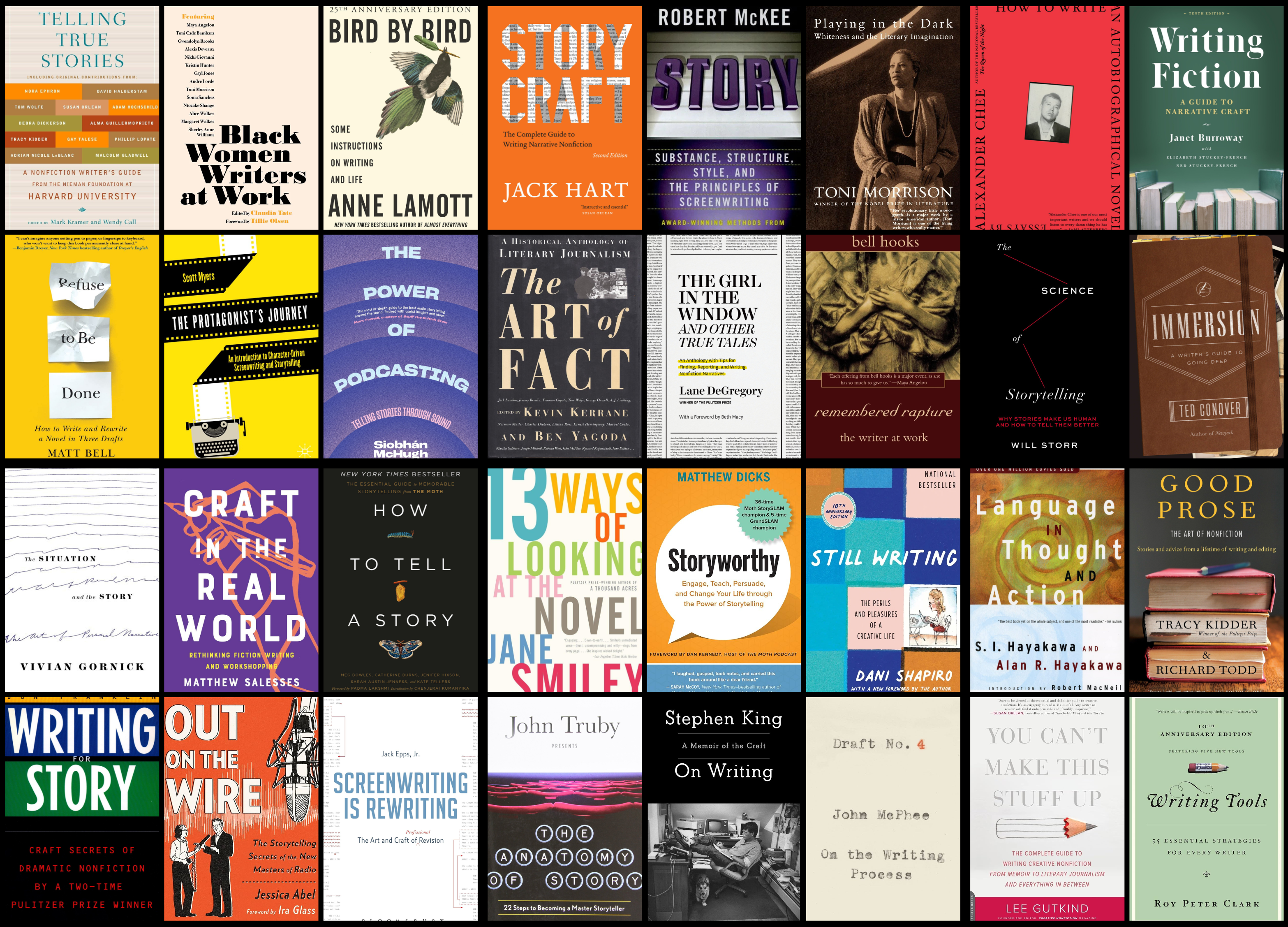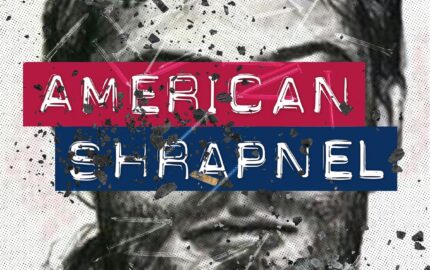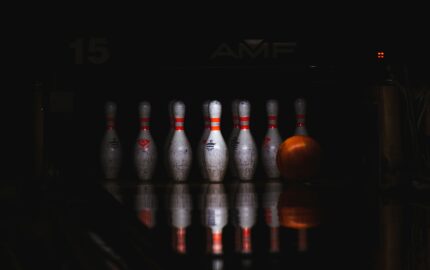In my office, I have a long table full of books that share a common theme: they’re all focused on the craft of storytelling and writing.
I’ve turned to these craft books time and time again, and I never seem to outgrow them. I recommend them to my journalism students at the University of Texas at Austin and often refer to them myself — especially in moments when I am navigating a writing challenge, craving a dose of creative inspiration, or needing a reminder that the work we do as writers matters.
Craft books proved especially helpful while I was writing my debut narrative nonfiction book, “SLIP,” which comes out in August 2025. In particular, they sharpened my vision of what’s possible when structuring a book like mine, which blends memoir, reportage, and science.
To put together this list of books on storytelling, we asked journalists, authors, producers, filmmakers, and you, our Nieman Storyboard readers, for recommendations — and you more than came through. I’ve also included some of my own favorites, including work from the likes of bell hooks and Matthew Salesses. Though this list is by no means exhaustive (I could write a whole book about all the craft books that exist), it nevertheless captures an array of genres and perspectives that writers of all kinds can learn from.
Writing, storytelling, and general inspiration
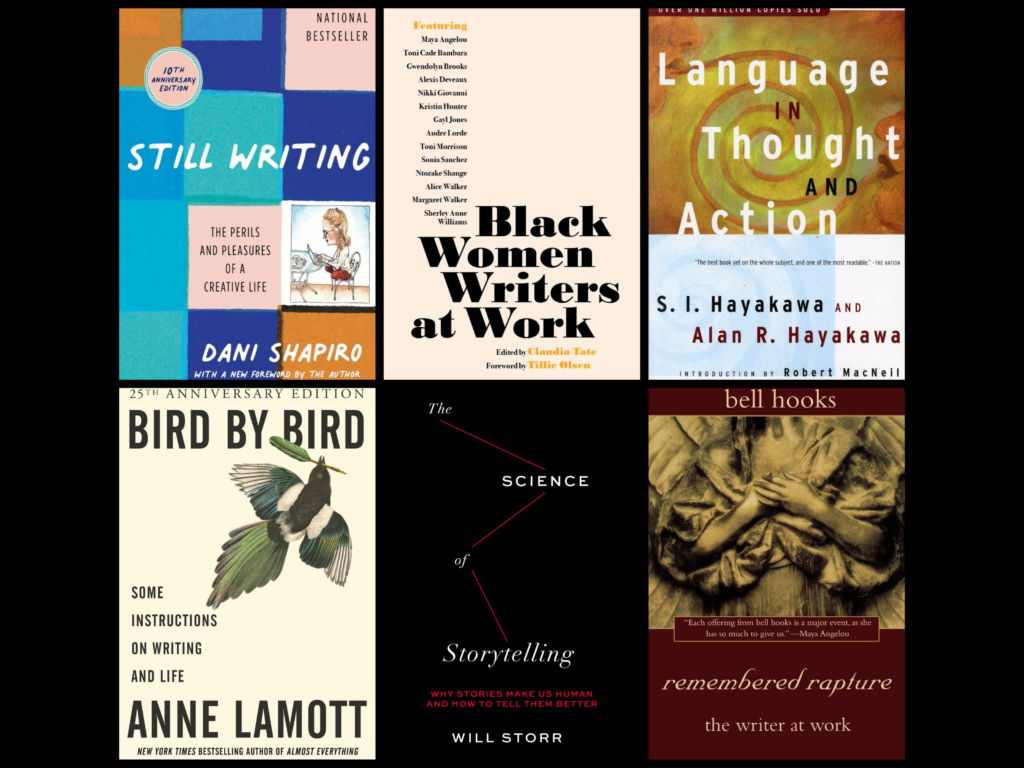
- “Bird by Bird: Some Instructions on Writing and Life,” by Anne Lamott, is equal parts witty and instructional. This classic explores myriad topics, including perfectionism, which Lamott refers to as “the main obstacle between you and a shitty first draft.” Several Nieman Storyboard readers recommended this book, including writing coach Ben Riggs, who said: “While her ‘shitty first drafts’ is famous, her chapter on ‘character’ is so underrated.”
- “Still Writing: The Perils and Pleasures of a Creative Life” by Dani Shapiro. Full of mini meditations on the craft of writing, this book is a worthy addition to any writer’s library. The audiobook version includes a guided meditation and a micro-journaling exercise that makes for a great daily writing practice and a helpful classroom exercise.
In 2023, Haymarket Books answered one of my literary prayers by re-releasing “Black Women Writers at Work.” In interviews with Claudia Tate, The Greats — Toni! Maya! Audre! Nikki! Alice! (To name a few) — discuss not only their craft, but grant us insight into the details of their writing life, how they do the work of writing as Black women and the everlasting importance of that work. Often times, the writing life can feel very opaque, and there are additional hurdles I must overcome as a Black woman writer to establish myself in this industry, so it’s validating to know that this is the lineage I’m writing into. This book is the blueprint.
— Storyboard contributor and author Minda Honey ("The Heartbreak Years")
- “Remembered Rapture” by bell hooks is a remarkable collection of essays that blends the personal and intellectual to celebrate the joys of writing and reading. She tackles topics that are often overlooked in craft-related books, including how writing can be redemptive, how identity shapes our work as writers, and the class and politics of writing.
- “The Science of Storytelling” by Will Storr weaves together psychological research, neuroscience, and narrative to relay writing-related best practices. To illustrate his points, Storr pulls from a wide range of writing samples featuring Jane Austen, Native American folk tales, Shakespeare, “Breaking Bad” scripts, and more. Nieman Storyboard reader Donna Otter says Storr’s advice on the “five-act structure” for storytelling is especially helpful.
- “Language in Thought and Action” by S.I. Hayakawa explores the role of language in human life and the ways in which it shapes our thinking. The book features an especially helpful section on “the ladder of abstraction,” a tool that helps writers think about how to move between abstract ideas and concrete details to tell more compelling narratives.
Subscribe to Storyboard
Get insights into the craft of journalism and storytelling in your inbox, delivered on Fridays.
Storytelling in journalism

- “Telling True Stories: A Nonfiction Writer’s Guide,” The Nieman Foundation's own collection, edited by Mark Kramer and Wendy Call, features essays from some of the field’s greats, including Isabel Wilkerson, Gay Talese, Kelley Benham French, Tom Wolfe, and Susan Orlean. It’s a fan favorite among Nieman Storyboard readers, including feature writer Will Coldwell, who says: “Whenever I hit a block with a story, I go back to this book.”
- “The Girl in the Window and Other True Tales” by Lane DeGregory is a wonderfully curated collection of DeGregory’s Tampa Bay Times stories, including her Pulitzer-winning longform narrative, “The Girl in the Window.” DeGregory includes annotations alongside each story, offering up tips on channeling your subject’s voice, celebrating tension, and finding meaning in details.
- “Writing Tools: 55 Essential Strategies for Every Writer” by Roy Peter Clark is an essential go-to book for journalists. Clark, a longtime writing coach, offers tried and true tips to enhance your journalistic storytelling, whether you’re reporting breaking news stories or longform narratives. Tips include “get the name of the dog,” “order words for emphasis,” and “draft a mission statement for your work.” Nieman Storyboard reader Ben Riggs also recommends Clark’s “Murder Your Darlings.”
- “Good Prose: The Art of Nonfiction” is the result of a longtime collaboration between Pulitzer winner Tracy Kidder and his editor Richard Todd. They’re in conversation with each other throughout the book, which digs deep into relevant topics for journalists, including the ethical challenges of nonfiction and how to find story ideas in surprising places.
- Finally, journalist and professor Erika Hayasaki mentions several books that are used in the Literary Journalism program at UC Irvine, including “Immersion: A Writer's Guide to Going Deep,” by Ted Conover; “The New New Journalism,” by Robert Boynton; “The Craft of Science Writing,” edited by Siri Carpenter; and “The Art of Fact,” edited by Kevin Kerrane and Ben Yagoda.
Narrative nonfiction
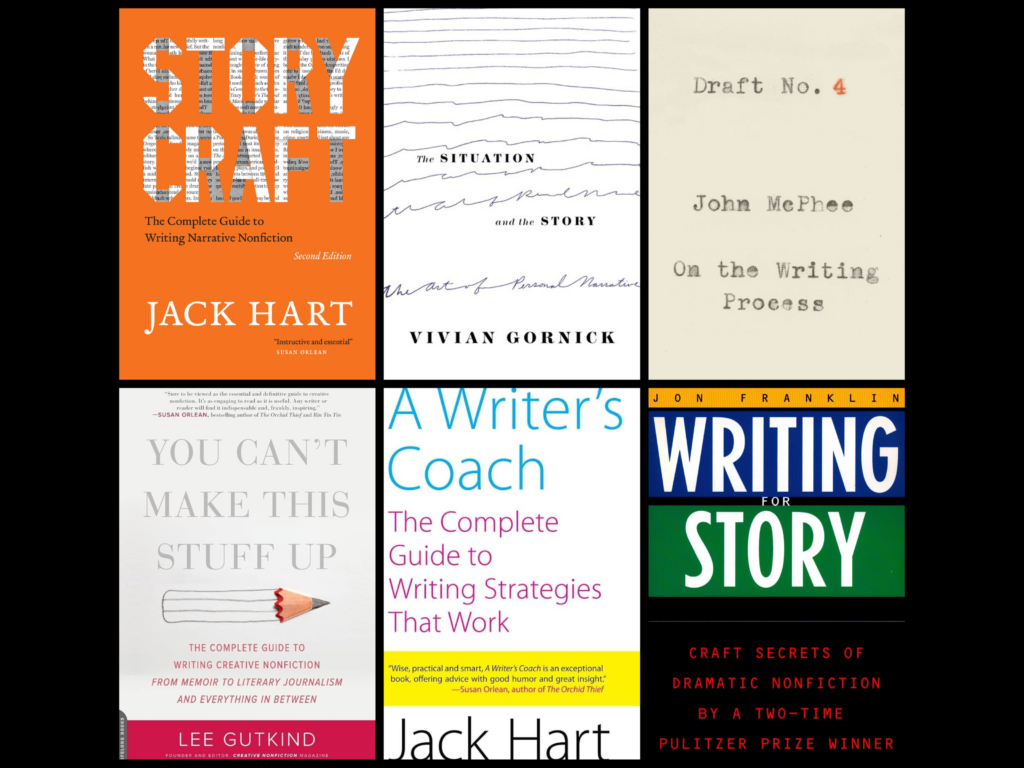
- “The Situation and the Story: The Art of Personal Narrative” by Vivian Gornick came highly recommended by several Nieman Storyboard readers, including author Julia Scheeres ("Jesus Land," "A Thousand Lives"). The book explores the delicate and complicated art of writing about oneself and figuring out which “selves” we want to bring to our stories. As Gornick writes: “To fashion a persona out of one’s own undisguised self is no easy thing.”
- “Story Craft: The Complete Guide to Writing Narrative Nonfiction” by Jack Hart dives into the craft of narrative nonfiction and also offers up tips on when not to use narrative. Hart provides helpful examples from a variety of fields, including journalism, podcasting, and documentary storytelling. Patti Wolter, professor at Northwestern’s Medill School of Journalism, recommends reading “Story Craft” alongside Hart’s other book, “A Writer’s Coach.”
- “Draft No. 4: On the Writing Process” by John McPhee includes tips and personal anecdotes on reporting, writing, and revising narrative nonfiction. The section on structure (which I turned to when figuring out how to structure my own memoir) features creative approaches not seen elsewhere, coupled with simple diagrams to help you visualize how each structure plays out on the page. “Readers are not supposed to notice the structure,” McPhee writes. “It is meant to be about as visible as someone’s bones.”
- “Writing for Story: Craft Secrets of Dramatic Nonfiction,” by two-time Pulitzer winner Jon Franklin, is a master class in writing narrative nonfiction. With expertly wrought chapters, Franklin explains how to use some of the best elements of fiction — including flashbacks, foreshadowing, and complication/resolution — when writing nonfiction. Throughout the book, he provides detailed annotations of his own work to help readers see his tips in action. (For more on Franklin, read this tribute from Storyboard editor emerita Jacqui Banaszynski.)
- “You Can't Make This Stuff Up: The Complete Guide to Writing Creative Nonfiction" is a great read by Lee Gutkind, who has been referred to as “the Godfather behind creative nonfiction.” The book provides a comprehensive overview of the genre and includes related writing and reading exercises. The book came highly recommended by longtime journalist Nick Pappas, who said it was instrumental in helping him write his own narrative nonfiction book.
Oral storytelling: podcasting and live stories onstage
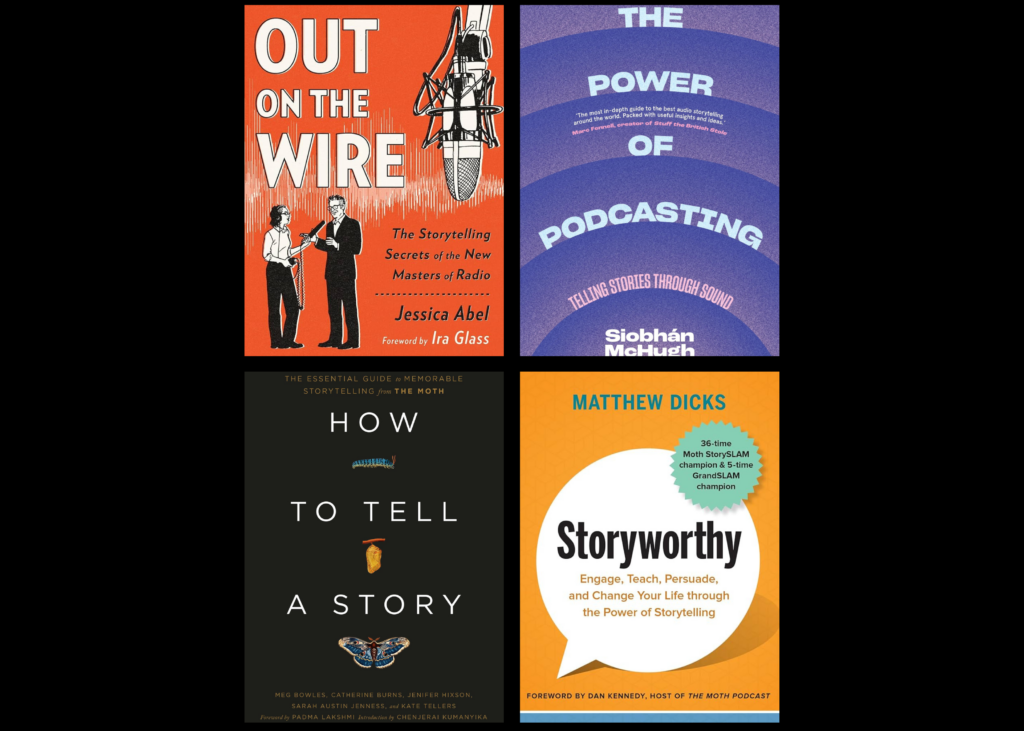
- “Out on the Wire: The Storytelling Secrets of the New Masters of Radio,” by Jessica Abel, is a fascinating graphic narrative that uses visuals to offer up a behind-the-scenes look at story-driven radio shows such as “This American Life,” “Planet Money,” and “RadioLab.” Accessible and fun to read, the book is an essential guide for anyone who wants to advance their audio storytelling and podcasting skills.
"['Out on the Wire'] is not at all just for radio — the lessons are applicable across genres whenever the goal is to tell character-driven stories with characters that grow and change and learn new things and thus engage and surprise the reader/listener/viewer. Two takeaways in particular I come back to again and again:
1. (To myself) Topics vs. stories vs. big ideas. What's the big idea that makes this story interesting to everyone on the planet?
2. (To others while interviewing) Expectations vs. reality: How did you think it was going to be before you started? And then what was it actually like? Why do you think what happened happened?
— Journalist Esmé E. Deprez
- “The Power of Podcasting: Telling Stories Through Sound” is a fan favorite written by podcast scholar Siobhan McHugh, who has been an audio storyteller for four decades. Many Storyboard readers recommended this book, including Macquarie University’s Helen Wolfenden, who said: “McHugh’s passionate connection to spoken-word audio infuses every page. … Practical and wise, it is a love letter to voice and tape and makes the case about the power of stories that come to us via our ears.”
- “Storyworthy: Engage, Teach, Persuade, and Change Your Life Through the Power of Storytelling” by Moth StorySLAM champion Matthew Dicks, conveys an important message: We all have a story worth telling. Dicks shares practical tips for sharing your stories onstage and on the page, and he shows how storytelling can have a profound impact on our lives. (Nieman Storyboard editor Mark Armstrong highly recommended this one, alongside William Zinsser's "On Writing Well" (also picked by Storyboard reader Karen Springen), Christopher Vogler's "The Writer's Journey," and Verlyn Klinkenborg's "Several Short Sentences About Writing.")
- “How to Tell a Story: The Essential Guide to Memorable Storytelling from The Moth,” by Meg Bowles, Catherine Burns, et al. Journalist Cyndi Zaweski praised this book for the insightful way that it explains how to be vulnerable when sharing personal narratives. “Vulnerability in storytelling isn't about recounting all the details of the ‘bad thing’ that happened to you,” she said, drawing upon lessons learned from the book. “That's just the context for the real story: what you learned and how it changed you.”
Screenwriting
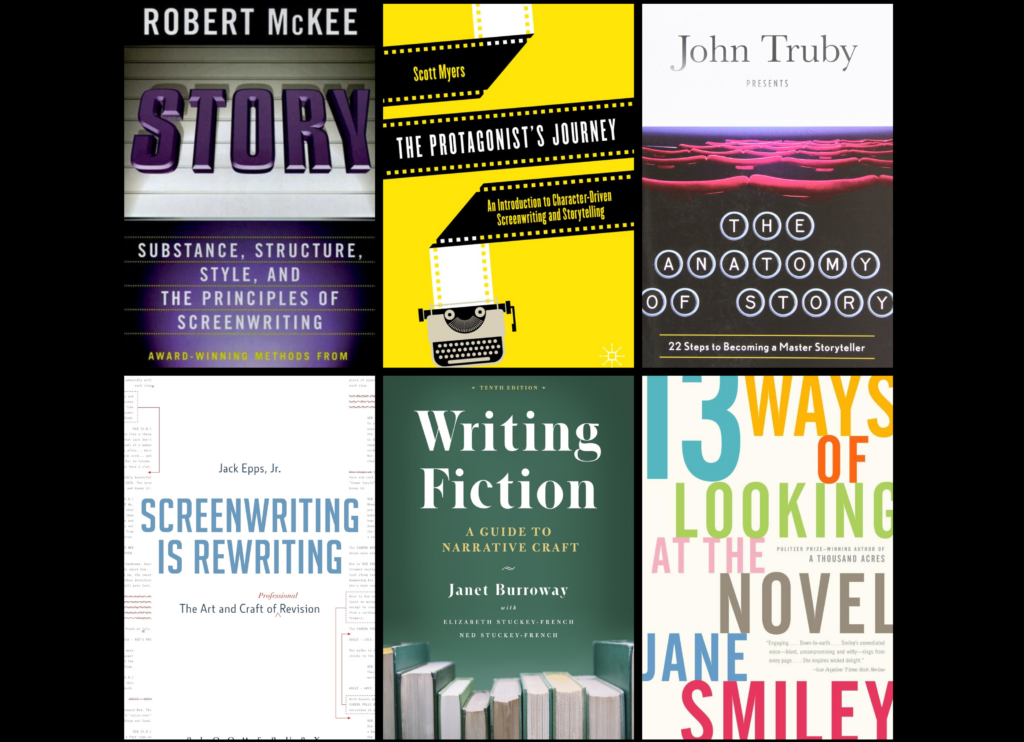
- “The Protagonist's Journey: An Introduction to Character-Driven Screenwriting and Storytelling,” by Scott Myers, is an encouraging guidebook for those at the start of their screenwriting journeys.
• "Protagonist's Journey": I've been reading Scott for as long as I can remember working in Hollywood, and I've known him personally for more than a decade now, since I asked him to be the official screenwriting blogger of the Black List. His is a non-prescriptive approach, and I don't know that I've met anyone who cares more about aspiring professional screenwriters than he."
• "Poetics," by Aristotle: The earliest surviving work of Greek dramatic theory. Start at the beginning.
— Franklin Leonard, producer and founder of the screenwriting and storytelling community The Black List
- “Screenwriting is Rewriting: The Art and Craft of Professional Revision” by Jack Epps Jr. is an indispensable guide to the craft of revision in screenwriting. Epps, who co-wrote films such as “Top Gun” “The Secret of My Success,” and “Anaconda,” explores the many layers of the rewrite process and explains how they can enhance the final product.
- “Story: Substance, Structure, Style, and The Principles of Screenwriting” by Robert McKee is an insightful manual from a master of the craft. The book offers practical advice for seasoned and aspiring screenwriters, and it illuminates deeper truths about how one can harness the power of good storytelling to capture and captivate an audience.
“Story by Robert McKee is my Bible. The book is very much about telling writers to get out of their own way. Taught me so much. Second is Janet Burroway's “Writing Fiction,” which is the most practical craft book I've read on the elements of fiction, followed by “13 Ways of Looking at the Novel” by Pulitzer Prize winner Jane Smiley.”
— Author Maurice Carlos Ruffin ("The American Daughters," "We Cast a Shadow," "The Ones Who Don’t Say They Love You")
- “The Anatomy of Story: 22 Steps to Becoming a Master Storyteller” offers up multifaceted tips and techniques from John Truby, a screenwriter, director, and acclaimed story consultant. The book tackles character, dialogue, tone, structure, and symbolism, and it “is great for helping anyone think about plot,” says writer and Nieman Storyboard reader Maura Kelly.
Fiction
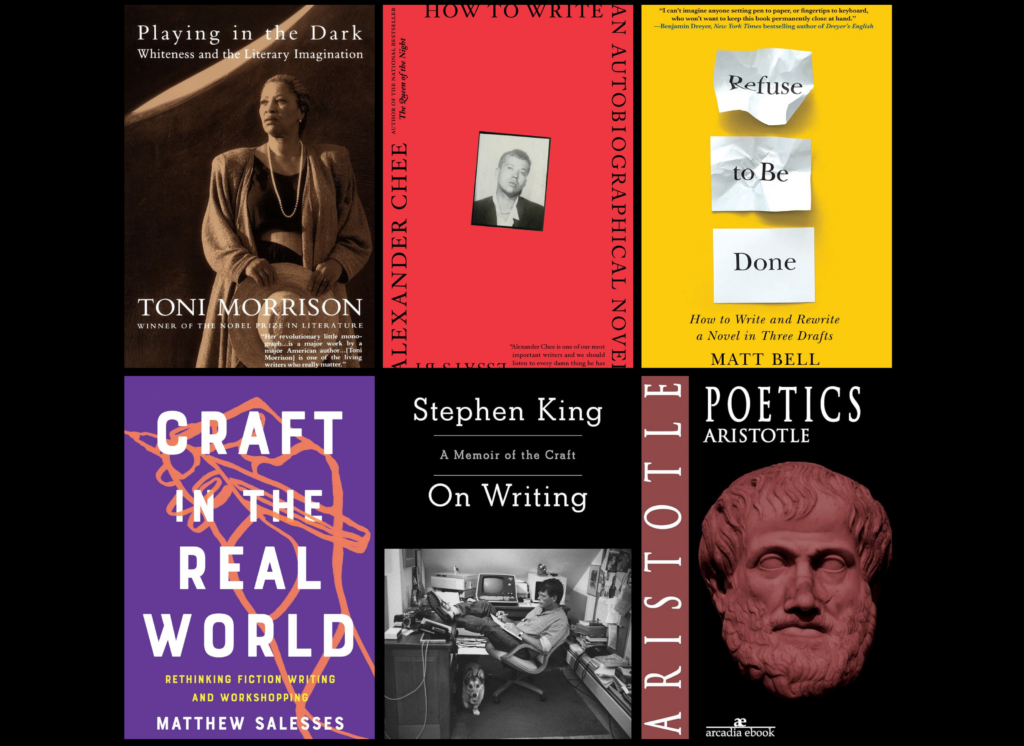
- “Playing in the Dark: Whiteness and the Literary Imagination” by Toni Morrison. Author Shannon Sanders ("Company") first read this book in college and remembers being “haunted” by Morrison's lucid ideas and prose. “The book is about how African-Americans and Blackness generally have shaped the (predominantly white) classic American canon, but beyond that it taught me how in reading a text there is so much you can slice straight through and instead read the author: in their choice of symbol and motif, in the preoccupations they emphasize on purpose and by accident, you can access a new understanding of a world (perhaps the very world you live in, though you probably see it differently from, say, Willa Cather),” Sanders said. “As a Black writer starting out, I was very affected by this and return to it often when I am considering my own body of work.”
- “How to Write an Autobiographical Novel” by novelist Alexander Chee is a critical addition to the canon of craft books. Sanders, quoted above, calls it a “contemporary classic,” saying: “I think many writers feel a lot of loneliness and yearning because of how much of our lives we spend pulled away from our desks, agonizing through real-world experience and hoping to be able to bottle the tiniest bit of that experience in our work. Chee's book makes me feel less alone in that way of living.”
- “Craft in the Real World: Rethinking Fiction Writing and Workshopping” by Matthew Salesses is an essential read for educators who want to rethink traditional approaches to creative writing workshops and carve out new pathways forward. Salesses poses thought-provoking ideas about how to integrate diverse storytelling traditions into workshops and classroom teachings, and he shares practical suggestions on grading and creating syllabi for writing classes.
- “Refuse to be Done” by Matt Bell is a super practical guide for anyone who is working on a novel or aspires to do so. The book, recommended by Nieman Storyboard reader Tara Yarlagadda and author Deesha Philyaw ("The Secret Lives of Church Ladies"), is broken down into three sections that focus on writing, rewriting, and revising (a topic that often gets overlooked in craft books). Bell makes the daunting task of writing a novel seem more doable by laying out a roadmap and acting as a trusted guide.
- “On Writing” by Stephen King is a classic go-to for many Nieman Storyboard readers, including Yarlagadda, who appreciates King’s advice on how to develop a writing lifestyle. Personally, I like King’s insistence that writers mustn’t wait for the “perfect” conditions to begin writing. When teaching lectures on procrastination, I read aloud a related passage from King’s book: “I wrote my first two novels, ‘Carrie’ and ‘Salem’s Lot’ in the laundry room of a doublewide trailer, pounding away on my wife’s portable Olivetti typewriter and balancing a child’s desk on my thighs.” My students always look back at me, wide-eyed. This is perhaps one of the most telling signs of a good craft book: when it provides anecdotes and lessons you remember and can’t help but want to share.
With King's advice in mind, I hope you’ll share this guide with other writers and journalists in your life — and remember that picking up a pen will teach you so much on its own.
***
For more resources for writers and journalists, check out Nieman Storyboard's books coverage, and our entire Story Craft archive.
***
Mallary Tenore Tarpley is a journalism professor at the University of Texas at Austin’s School of Journalism and Media. Her debut narrative nonfiction book, “SLIP,” will be published by Simon & Schuster’s Simon Element imprint in August and is now available for pre-order. She recently launched a newsletter, Write at the Edge, geared toward helping writers hone their craft.
